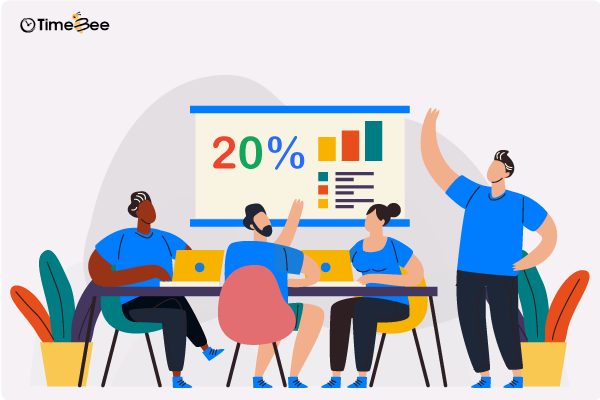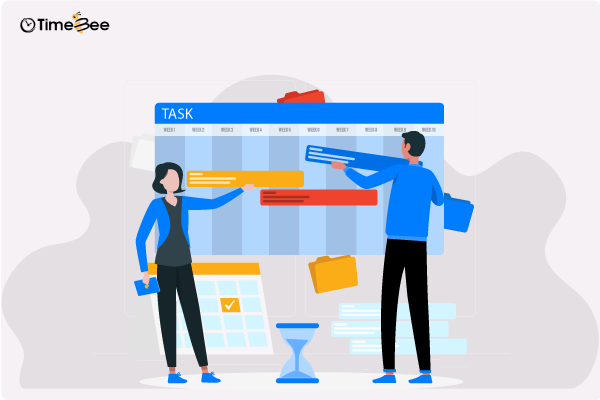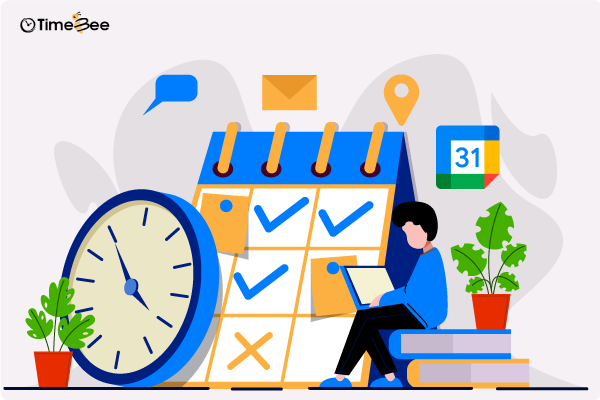Content
Content
You might think that an experienced professional would have mastery over their work and that their tasks are always on time. For some this is true, but there’s a silent majority of workers who find it challenging to be productive and use their time efficiently.
This is also backed by several scientific studies. An average worker is productive for roughly two to three hours in an eight-hour workday, so their efficiency is only 25 to 30%.
Many employers find this unacceptable, and rightfully so. When time and millions of dollars are on the line, low output simply doesn’t work.
To counter this, we’ve illustrated have 5 examples of innovative productivity and efficiency techniques that employers have used to maximize output.
What Is Productivity At Work?
Work productivity means the effectiveness with which an individual, team, or organization uses its resources to achieve desired outcomes. It measures how well tasks and goals are accomplished relative to the resources invested, including time, effort, and energy.
If an employee was assigned 3 tasks and he was only able to complete one, it means their productivity was low.
5 Examples Of Productivity At Work
These are the five examples of Productivity and Efficiency at Work.
Example 1: Google’s 20% Time:

Google famously implemented a policy known as “20% time,” allowing employees to spend 20% of their work hours on projects of their choosing.
This policy has resulted in some of Google’s most innovative products, including Gmail and Google Maps.
This approach encourages creativity and allows employees to pursue passion projects, ultimately boosting productivity and innovation.
Example 2: Toyota’s Kaizen Philosophy:

Toyota is known for its commitment to continuous improvement through the Kaizen philosophy. Employees at all levels are encouraged to suggest and implement small, incremental changes to improve processes.
This dedication to constant improvement has played a significant role in Toyota’s success and is a powerful example of how focusing on incremental improvements can lead to sustained productivity gains.
Example 3: Asana’s Task Management System:

Asana, a project management tool, is an example of a company that not only develops productivity tools but also embodies a culture of productivity.
The company uses its own platform to manage tasks and projects, fostering clear communication and collaboration among team members.
Asana’s success illustrates the impact of effective project management on overall workplace productivity.
Example 4: Zappos’ Holacracy Experiment:

Zappos, an online shoe and clothing retailer, experimented with a management approach called Holacracy, which distributes decision-making authority across self-organizing teams.
While the experiment had its challenges, it showcased a commitment to finding new and innovative ways of organizing work.
This willingness to explore alternative structures can inspire other companies to think outside the traditional hierarchical model to enhance productivity.
Example 5: 3M’s Innovation Time Off:

3M, the multinational conglomerate, is known for its commitment to innovation. Employees are given time off from their regular duties to pursue projects. This approach has led to the development of iconic products like Post-it Notes.
3M’s emphasis on allowing employees to explore and innovate during work hours demonstrates the value of allowing time for creative thinking and problem-solving.
Importance Of Productivity At Work
Implementing strategies for better work productivity pays off in spades.
Some of the benefits include:
- Meeting Goals: Productivity is crucial for meeting organizational goals and objectives. When individuals and teams are productive, they are more likely to accomplish tasks promptly, contributing to overall success.
- Competitive Advantage: Productivity often translates into a competitive advantage. Organizations that produce more output with the same or fewer resources are better positioned to compete in the market.
- Employee Satisfaction and Engagement: Productive work environments contribute to employee satisfaction and engagement. When individuals feel their work is meaningful and they are making progress, it can enhance morale and job satisfaction.
- Innovation and Growth: Productivity is closely linked to innovation and business growth. Efficient use of resources allows organizations to invest in research and development, leading to new products and services.
- Customer Satisfaction: Productivity can impact customer satisfaction. When organizations can deliver products or services in a timely and efficient manner, it enhances the customer experience and builds loyalty.
How Can You Improve Productivity At Work? 5 Best Practices
Start With Difficult Tasks First
Start your day by focusing on the harder tasks first. This way, you will have more time to tackle more energy-intensive and demanding tasks and won’t rush under pressure. Knocking off bigger challenges from your plate will also boost your confidence, helping you achieve more thanks to momentum.
Break Bigger Tasks Into Smaller Subtasks
Organize your tasks into smaller chunks so they are easier to tackle and require less energy and resources. This will also reduce the likelihood that you will procrastinate or defer tasks because you feel unsure where to begin.
Take Small Breaks
Take small breaks throughout the day to keep your mind refreshed and your energy high. Moving around and completing a small task may even provide a sense of accomplishment that can help build your productivity and motivation. Taking a step back to take care of your body and mind can help you reduce stress and feel more rested, productive, and attentive when you return to your work.
Minimize Distractions
Minimize distractions. Close any unwanted tabs, mute your notifications, and put your phone away. If there is a lot of noise around you, use noise-canceling headphones to drown your surroundings so you can better focus on the task at hand.
Use Productivity Management Software
Productivity management software helps you align goals so you have a better understanding of your time limits and budget. This allows you to proactively tackle your work goals, minimize distractions, and ensure you aren’t wasting time on unnecessary or redundant tasks.
Now let’s get into real-world examples of inspiring productivity and efficiency in the workplace.
What Is Efficiency At Work?
Work efficiency means the maximum output one can get for the minimum amount of input effort. It means that working more with less. The mantra work smart, not hard applies here. If employees focus on getting more done with less effort, they become more efficient and can do more work when time is of the essence.
Importance Of Efficiency At Work
Efficiency at work is crucial for various reasons, and it plays a significant role in the success and productivity of individuals, teams, and organizations. Here are 5 key reasons highlighting the importance of efficiency at work:
- Productivity Improvement: Efficiency directly contributes to increased productivity. When tasks are completed more quickly and with fewer resources, more work can be accomplished simultaneously.
- Time Management: Efficient work practices help individuals and teams manage their time effectively. This involves prioritizing tasks, setting realistic deadlines, and avoiding time-wasting activities.
- Cost Reduction: Efficiency often leads to cost savings. When processes are streamlined, and resources are utilized optimally, organizations can minimize expenses related to time, materials, and labor.
- Quality Enhancement: Improved efficiency can positively impact the quality of work. When individuals focus on completing tasks effectively, there is more time and attention available to ensure that the work meets high standards.
- Employee Morale: Efficient work environments can increase job satisfaction and employee morale. When individuals feel that their efforts result in meaningful outcomes, they are more likely to be motivated and engaged.
How Can You Improve Efficiency At Work? 5 Best Practices
Here are 5 ways to improve efficiency at work.
Set Clear Goals
Define specific, measurable, achievable, relevant, and time-bound (SMART) goals for yourself and your team. Clear goals provide a sense of direction and purpose, making it easier to prioritize tasks and stay focused.
Prioritize Tasks
Use prioritization techniques such as the Eisenhower matrix to categorize tasks based on urgency and importance. Focus on high-priority tasks first to ensure that critical objectives are addressed promptly.
Manage Time Effectively
Develop strong time management skills by creating schedules, setting deadlines, and using tools like calendars and task management apps. Break larger tasks into smaller, more manageable steps.
Minimize Distractions
Identify and minimize sources of distraction in your work environment. This could include turning off non-essential notifications, designating specific times for focused work, and creating a dedicated workspace.
Use Technology Wisely
Leverage productivity tools and software to streamline tasks. Project management tools, time tracking tools, communication apps, and automation can significantly reduce manual workload and enhance collaboration.
The last 3 tips can be effectively implemented by using time management software. It will take the load off you since you no longer have to rely on manual time tracking, and your employees won’t try to evade you.
5 Examples Of Efficiency At Work
These are the five examples of Productivity and Efficiency at Work.
Example 1
Apple and Microsoft were competing to release their operating systems. What took Microsoft 5 years and 10,000 employees took Apple 2 years and 600 employees, resulting in a superior Apple product.
While Microsoft rewarded individual performance, Apple was committed to rewarding exceptional team performance. Thus, Apple inspired the whole team to work collectively and focus on efficiency, not just personal productivity.
Example 2
We will once again look at Google for inspiration. According to Forbes, Google is in the top 5 most valuable companies in the world. It’s not only the most innovative organization to work at, but it’s also one of the most fun. The company knows that no one who is unmotivated will work with them, and their efficiency will naturally be relatively low.
So, to avoid this and keep employees motivated to produce at a high level, Google provides extra benefits. From free meals to free dry cleaning to games, nap pods, and on-site physicians, the company knows how to keep people satisfied. It might seem like a lot to offer, but the cost of high turnover is greater.
Google also uses the data it collects on its employees. For example, it learned that if the lunch line were too long, productivity would go down. But if the line were nonexistent, employees wouldn’t meet and talk to each other.
Example 3
Zoom wanted to change the workforce culture. Its founder, Eric Yuan, left his six-figure salary at Cisco Webex because he was so unhappy. So, when he started Zoom, he made it his mission to ensure he hired the right people—passionate leaders who lead by example.
When you have that kind of commitment to happiness and excellence from the top down, employees respect that and work harder. Zoom employees rated Eric Yuan as the top CEO on Glassdoor and gave him a 99% approval rating.
Sometimes, it’s the little things that matter the most. For example, Zoom provides its employees a stipend each month for a gym membership. Even when the pandemic started, and people couldn’t go to the gym, they still gave that money to employees for groceries or whatever else they wanted.
Example 4
Procter & Gamble (P&G) has a reputation for innovation and efficiency in product development. The Connect + Develop program encourages collaboration with external partners, including startups and innovators, to tap into a broader range of ideas and expertise. This external collaboration has allowed P&G to streamline its research and development processes, bringing new products to market more efficiently.
Example 5
Many manufacturing companies have successfully implemented lean principles to optimize their production processes. Lean focuses on minimizing waste, improving flow, and continuously optimizing processes. Ford is a classic example of a company that pioneered lean manufacturing, leading to increased efficiency and reduced production costs.
| Productivity | Efficiency |
| Productivity measures output over time | Efficiency measures input versus output. |
| The measure of the amount of work a person can do | The effort required to do said work |
| Takes into account both the amount of work completed and the worth of that work | Only look at how much effort was put into the work |
| Measures personal performance | Measures process performance |
| Productivity is harder to measure | Efficiency can be measured |
| Productivity is examined at the end because of the goals set | Efficiency can be calculated at any point in time |
Productivity is independent of repetition | Efficiency can only be improved after repetition |
Leveraging TimeBee For Increasing Productivity & Efficiency At Your Workplace
Use TimeBee to organize tasks and projects while managing time. This helps you kill two birds with one stone as TimeBee increases your employees’ productivity and efficiency. Categorize tasks based on priority and deadlines, which gives you and your employees a clear overview of what needs to be done and helps with effective planning.
TimeBee has accurate tools to track the time spent on different tasks. Monitoring time can help identify areas where productivity can be improved and provides insights into how long various tasks take. This measures the accurate efficiency and productivity levels of all of your employees.
Never let distractions distract you from important tasks. If your screen sits idle, an alert will appear, helping you re-focus.
This keeps employees focused on tasks so they don’t fall behind on deadlines, and their progress continues smoothly. Since the employer can see the time tracking of each employee, this way everyone is on the same page, and reduce unnecessary delays.
TimeBee also provides advanced tracked time analytics and reports. Use these features to analyze productivity trends, identify bottlenecks, and make data-driven decisions to improve efficiency.
TimeBee integrates with other workplace tools or apps and leverages these integrations to streamline workflows. For example, integration with project management or communication tools enhances overall efficiency. So use TimeBee to your advantage and boost your work efficiency and productivity quickly.
Categorize sites into productive, unproductive, and neutral to ensure your employees are focusing on work and not getting distracted. Also, get real-time reports instantly to make changes for the betterment.
Know which of your resources are available to schedule and assign the tasks. Easily manage leaves and holidays through Time Bee. Also, set a custom hourly rate for each of your employees so you know the compensation each one deserves for their efforts. to know each individual’s effort.
So, as you can see TimeBee has a lot of tricks up its sleeve that, if you use them to their full potential, can supercharge your workplace’s productivity and efficiency tenfold.
Conclusion
Although similar, efficiency and productivity have different meanings in context. The inspiring examples we have given above show one thing they have in common: Employees who show productivity and efficiency are significantly rewarded. With the right tools, this can be maximized to tap into a worker’s full potential.
Moreover, successful companies often combine multiple strategies to create a culture of continuous improvement and innovation, ultimately enhancing efficiency in their operations.
Similar Reading



